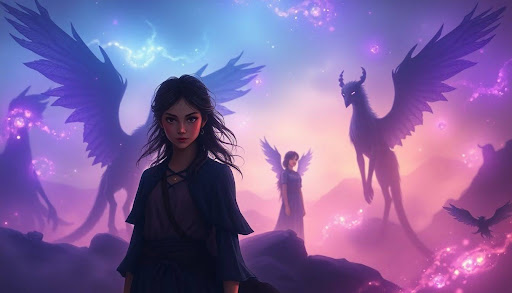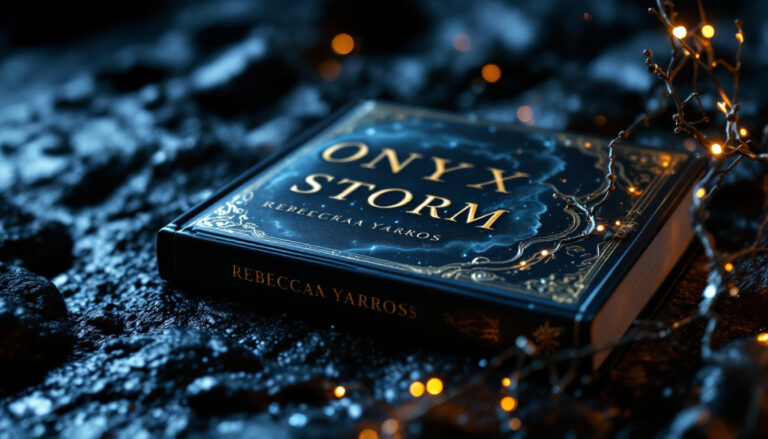House of Earth and Blood by Sarah J. Maas – Honest Review for Readers
Sarah J. Maas is no stranger to captivating fantasy fans, but House of Earth and Blood marks her bold step into adult fiction. As the first in the Crescent City series, this book combines urban fantasy with rich world-building, creating a blend of magic, mystery, and modernity. Fans of her young adult series, like Throne of Glass and A Court of Thorns and Roses, may feel right at home with her signature character-driven storytelling—only this time, it’s darker, grittier, and far more intense. With its growing popularity, readers everywhere are curious: does this genre shift deliver?
What is House of Earth and Blood About?
Sarah J. Maas introduces readers to an intensely crafted world that blends ancient myths with sleek, modern aesthetics in House of Earth and Blood. The novel follows an emotional, gripping journey as its characters navigate a tangled web of murder, loss, and resilience. Let’s dive into the details.
The Setting: Crescent City
The story takes place in Lunathion, more commonly known as Crescent City—a bustling urban fantasy world teeming with magical beings and advanced technology. Imagine skyscrapers and glowing neon lights paired with the timeless aura of a city thriving with Fae, angels, werewolves, and merfolk. It’s like taking a walk through New York City, but on a magical steroids blend.
What sets Crescent City apart is its juxtaposition of Norse-inspired mythology woven seamlessly into a contemporary urban context. Technology is just as significant as ancient spells, and the merging of these elements adds depth to the narrative. This mix reminds readers that Crescent City has all the grit and high-tech ambiance of a modern metropolis, yet it thrives on an undercurrent of timeless magic and tradition.
For more insight into the city and its unique vibe, check out the Crescent City Series Overview.
The Main Characters
At the core of House of Earth and Blood are its unforgettable characters. Bryce Quinlan, a half-Fae, half-human protagonist, is the beating heart of the story. Bryce is the epitome of a modern heroine—smart, passionate, fiercely protective of those she loves, yet deeply flawed. Her life takes a tragic turn early on, forcing her to grapple with grief, guilt, and the search for justice. She’s not polished or perfect but is as real and relatable as a character in a fantasy universe can get.
Opposite Bryce is Hunt Athalar, a brooding angel with a dark past. Known as the Umbra Mortis, he serves as a slave to those in power but teams up with Bryce in her quest for answers. The dynamic between Bryce and Hunt is electrifying, marked by witty banter, undeniable chemistry, and a shared vulnerability that makes them a team you can’t help rooting for.
To explore more about Bryce, Hunt, and the other intriguing characters, visit Crescent City Character Breakdown.
The Central Plot and Themes
At its core, House of Earth and Blood is a murder mystery. Bryce’s best friend Danika, along with members of her wolf pack, is brutally killed, setting off a chain of events that thrust Bryce into a dangerous investigation. As she seeks to uncover the culprit, Bryce finds herself unraveling secrets that go far deeper than she anticipated.
However, the book isn’t just a whodunnit. Maas masterfully explores themes of love, sacrifice, and trust. The relationships—both romantic and platonic—are what anchor the story. Whether it’s Bryce’s fiercely loyal friendship with Danika, her fraught yet evolving bond with Hunt, or her moments of unexpected connection with others, each interaction taps into universal emotions. It’s a reminder of how far people will go to fight for those they care about.
Want the full summary of how these themes play out? The official Crescent City wiki provides a detailed walkthrough.
Strengths of the Book
While House of Earth and Blood has a thrilling plot with twists and turns, the book’s key strengths lie in its mesmerizing world-building, well-crafted relationships, and mature storytelling. Sarah J. Maas takes her writing to the next level by creating a narrative that doesn’t just entertain but pulls readers into a vivid and emotionally charged journey. Let’s break it down.
Impressive World-Building
Crescent City is a unique world that feels alive with its mix of ancient magic, advanced technology, and a vibrant urban setting. Maas crafts a city that’s easy to picture—a sprawling metropolis where skyscrapers and neon lights meet flying Fae, bustling marketplaces, and enchanted rivers. It’s as if she’s fused the mythical elements of high fantasy with the modern aesthetics of a city like New York. The result? A setting that’s not just a backdrop but an integral character in the story.
What stands out most is the attention to detail. Every district of Crescent City has its own identity, from the shadier areas ruled by gangs to the upscale neighborhoods of the elite Fae and angels. The layered history and societal structures add a level of realism that you rarely see in fantasy. You get the sense that this place existed long before the story started—and will stay with you long after you’ve put the book down.
To better explore Crescent City’s world-building, this guide provides an in-depth look at its unique elements.
Compelling Relationships
Relationships are at the heart of this book. Whether it’s friendships or romantic connections, Sarah J. Maas excels in creating bonds that feel real, raw, and unforgettable. Bryce’s friendship with Danika is a highlight—one that’s both heartbreaking and heartwarming. Even after tragedy strikes, their bond remains a driving force throughout the story. It captures the weight of grief but also celebrates the kind of unwavering loyalty that feels rare.
Then there’s Bryce’s dynamic with Hunt Athalar. Their relationship starts with reluctant partnership but slowly evolves into a connection full of mutual respect, vulnerability, and electric chemistry. The progression is natural, filled with playful banter, deeper emotional moments, and trust that grows organically. These connections make the story resonate beyond the fantasy elements, reminding readers just how powerful relationships can be.
For more insight into Maas’s exploration of relationships in the book, this review dives into the emotional depth of the characters.
Mature Storytelling
In her first adult fiction series, Sarah J. Maas doesn’t hold back. The themes in House of Earth and Blood are darker, grittier, and much more mature than her earlier works. Topics like loss, trauma, and societal corruption are handled with care and realism, giving the story a weight that appeals to adult readers. Bryce’s journey of coping with grief and finding herself again is relatable and raw. It’s messy and complicated—in the best way.
Additionally, the inclusion of moral complexities adds depth. Characters are not purely good or evil; they’re layered with flaws, making their decisions and struggles more compelling. It’s a reminder that life isn’t black and white, and neither is the world Maas has created. This mature approach to storytelling ensures that the narrative isn’t just escapism—it feels grounded and meaningful.
For readers curious about the balance between maturity and fantasy in the book, this in-depth piece delves into these themes beautifully.
Criticisms of House of Earth and Blood
While House of Earth and Blood has garnered a massive fanbase and notable acclaim, it’s not without its fair share of criticism. Readers have pointed out a number of issues ranging from pacing to character dynamics and the intense world-building. These critiques offer insight for potential readers who might approach the book with those elements in mind.
Pacing and Length Issues
One of the most consistent critiques leveled against House of Earth and Blood is its pacing. Many readers felt that the book starts off sluggishly, plagued by overly intricate detail that takes time to align with the flow of the narrative. The opening chapters are inundated with information about the world, its history, its creatures, and its systems—causing some readers to lose interest before the plot really picks up momentum.
The book spans nearly 800 pages, yet its pacing doesn’t always justify the length. A common sentiment expressed is that much of the early content could have been streamlined or integrated more organically. For fans and newcomers alike, this slow burn could either feel like a welcome opportunity to dive deeply into the world or an unnecessary delay in getting to the action.
One reader review shares this sentiment: “Maas throws in just about every magical creature possible, and then overwhelms the reader with recitations and descriptions that could easily have been pared down.” It’s a trade-off—those who love lush, detailed prose may adore it, but others find it burdensome.
Character Similarities and Predictability
Another point of contention is the similarity between Bryce Quinlan and characters from Maas’s earlier works. Critics argue that Bryce shares traits with Feyre (A Court of Thorns and Roses) and Celaena (Throne of Glass). The confident, witty, yet damaged heroine trope is undoubtedly a signature of Sarah J. Maas’s storytelling, but some readers find it repetitive across her series.
Additionally, certain plot elements feel predictable. Readers familiar with Maas’s writing style may notice recurring patterns, such as the archetype of a brooding male love interest or the heavy dependence on characters uncovering traumatic pasts that shape their narratives. While these elements resonate with many fans, others describe them as formulaic. In a critical review, a reader writes, “This book lacked originality in terms of plot and character, which is a shame as the world is really, really interesting.”
Dense World-Building
World-building is both a strength and a weakness for House of Earth and Blood. On one hand, Sarah J. Maas creates an incredibly elaborate and immersive setting, complete with various magical species, political systems, and hierarchies. On the other hand, this level of complexity often crosses into overwhelming territory.
The early chapters, especially, are rife with info-dumping. Readers are introduced to a myriad of locations, creatures, and rules at a dizzying pace. While the world is undeniably rich, its presentation can feel clunky and distracting. The flow of storytelling gets bogged down by the sheer volume of details thrown at the reader all at once.
In a critique of these structural choices, this analysis observes, “This book is, as the sages say, a bit of a mess. It starts slow and loads all its foundational work in a way that might put off readers who’ve come for engaging stories, not encyclopedias.” For those new to high fantasy or urban fantasy, Maas’s heavy world-building might feel inaccessible.
What can be frustrating for some is that, even with the length of the book, certain parts of the world remain unexplained or underdeveloped. Readers who thrive on complete understanding might find it hard to reconcile detailed but uneven world-building, an issue often discussed by critics and fans alike.
By addressing these critiques, it’s easier to see where the book struggles and what might deter certain readers. If you are someone who doesn’t mind a meticulous setup or prefers character-driven stories over breakneck pacing, these criticisms could feel less relevant to you. Nonetheless, they serve as critical insights for setting expectations before diving in.
Who Will Enjoy This Book?
House of Earth and Blood by Sarah J. Maas has a lot to offer across different reader groups. With a balance of thrilling urban fantasy, emotional character depth, and Maas’s signature storytelling style, it’s a book that appeals to a variety of tastes. Below, let’s explore who this book is perfect for.
Fans of Urban Fantasy
If you love modern settings filled with magic, supernatural beings, and a splash of mythology, this book will reel you in. Crescent City is a city unlike any other, where advanced technology blends with ancient magic and mythical creatures roam freely. Picture police investigations involving angels and crime scenes tied to ancient spells—this is the world Sarah J. Maas has brought to life.
The urban fantasy vibe is spot on for readers who enjoy exploring magical worlds that feel grounded in reality yet endlessly imaginative. For those who appreciate series like The Mortal Instruments by Cassandra Clare or The Dresden Files by Jim Butcher, Crescent City offers that same exhilarating blend of the mystical and the modern. For a deeper dive into how House of Earth and Blood stands out as an urban fantasy, check out this review.
Readers Who Love Complex Characters
Do you enjoy characters who feel real, flawed, and utterly relatable? Then you’ll find so much to love here. Bryce Quinlan, the book’s protagonist, is a half-Fae party girl who transforms into a fiercely determined woman seeking justice, all while grappling with grief and guilt. She’s messy and imperfect, which makes her growth throughout the story that much more rewarding.
The supporting characters offer just as much depth. Hunt Athalar, the brooding angel with a tortured past, brings raw vulnerability to the story. But it’s not just about the main pair—secondary characters like Ruhn (Bryce’s estranged brother) and Lehabah (an innocent fire sprite) steal the spotlight in their own moments. If characters who evolve and keep you guessing are your thing, this book delivers. For an overview of the rich character ensemble, refer to this Goodreads review.
Sarah J. Maas’s Devoted Fanbase
For dedicated Maas readers, House of Earth and Blood marks a significant milestone. It’s her first dive into adult fiction, and it doesn’t shy away from darker themes or mature content. Her trademark style—strong female protagonists, tantalizing slow-burn romances, and detailed world-building—remains intact but elevated to a new level. Fans of A Court of Thorns and Roses (ACOTAR) and Throne of Glass will feel right at home here.
This book also opens up a fresh side of Maas’s storytelling, giving loyal followers a chance to experience her voice in a more mature, urban setting. If you’re curious how this book compares to her earlier works, this breakdown offers great insights.
Whether you’re already a fan or exploring Maas’s writing for the first time, House of Earth and Blood offers an experience not to be missed.
Final Thoughts: Is It Worth Reading?
House of Earth and Blood by Sarah J. Maas has undoubtedly created a stir, earning both glowing praise and thoughtful critique. Whether the book is worth reading depends largely on your preferences as a reader and what you’re looking for in a story. Let’s break it down to help you decide.
Why You Might Enjoy It
This book delivers a powerful mix of urban fantasy, intricate world-building, and heart-tugging emotion. If you’re someone who thrives on epic settings, strong characters, and a good dose of romance, you’ll find much to love here. Readers often praise the immersive setting of Crescent City, with its neon-lit skyline and magical undercurrent, as a highlight. It’s not just a background—it feels alive, almost like another character in the story.
Bryce Quinlan is another strong point. She’s not perfect, which makes her so relatable. Her struggles with grief and identity add a realistic layer to the fantasy environment. Meanwhile, her evolving relationship with Hunt Athalar offers a balance of tension, chemistry, and emotional growth—all elements fans of Maas tend to crave. According to a review on Reddit, the book “pairs epic and detailed world-building with fantastic three-dimensional characters.”
Potential Drawbacks to Keep in Mind
On the flip side, the book isn’t without flaws. The pacing is one of the most frequently mentioned issues. The first 200-300 pages are heavy with info-dumping, which some readers find overwhelming or unnecessary. It’s a slow build, and for people who prefer fast-paced storytelling, this could feel like a drag.
Another critique is the length—spanning nearly 800 pages, the story sometimes feels unnecessarily drawn out. Even fans agree that the narrative could have been tightened, especially early on. “The beginning is inundated with detail, which doesn’t always feel purposeful,” according to one review.
Lastly, some readers feel there’s a sense of predictability, especially for those familiar with Sarah J. Maas’s writing. Common tropes like the damaged yet resourceful heroine or brooding love interest might feel repetitive if you’ve read her other series.
Who Should Read This Book?
- Urban fantasy lovers: If you enjoy stories that blend modern settings with magic, like The Mortal Instruments or The Dresden Files, this is right up your alley.
- Fans of Maas’s previous works: Those who loved A Court of Thorns and Roses or Throne of Glass won’t mind some familiar patterns for the reward of new characters and settings.
- Character-driven readers: If strong, evolving relationships are your thing, the dynamic between Bryce and Hunt will hook you.
- Those who enjoy detailed, immersive settings: Crescent City is like stepping into a world all its own—alive, vivid, and deeply intricate.
Who Might Want to Pass
- If slow pacing or heavy world-building frustrates you, this book might test your patience.
- For readers who prefer a self-contained, fast-moving story, the 800-page length may feel like a slog.
- If you’re expecting something completely new from Sarah J. Maas, the familiar character arcs and plot beats might disappoint.
Overall, House of Earth and Blood is an ambitious start to the Crescent City series. Fans of fantasy who aren’t afraid to invest time and emotional energy into the story will likely find it worthwhile. For additional insights, you can explore this book review on whatisquinnreading.com, which offers a balanced take on the book’s strengths and limitations.
Conclusion
House of Earth and Blood is an ambitious start to Sarah J. Maas’s adult fantasy series, showcasing her talent for immersive worlds and intense character bonds. While its vibrant blend of urban fantasy and deeply emotional storytelling strikes a chord with many readers, its pacing and complexity may not suit everyone.
If you love intricate world-building, character-driven plots, and stories that mix magic with modernity, this book is worth exploring. For those wary of slow beginnings or heavy exposition, patience is key—the payoff comes in the latter half.
Ultimately, Maas invites readers into a gripping narrative full of heartbreak, resilience, and hope. Curious to find out if it’s your style? Pick it up and decide for yourself—this series could be your next epic obsession.







